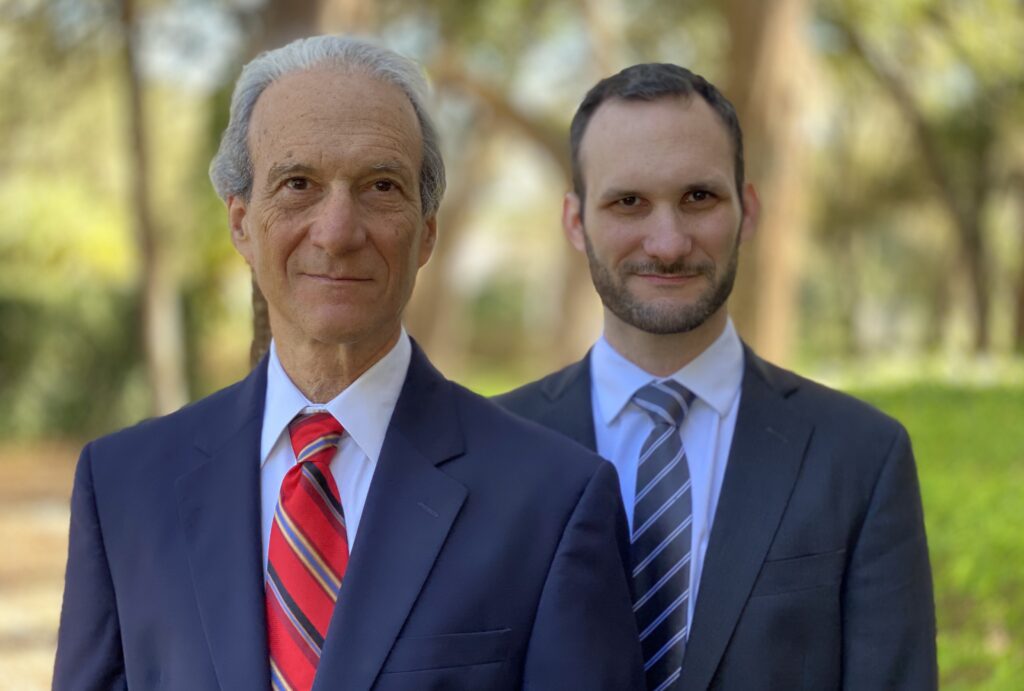
A Florida living trust allows you to avoid probate. Living trusts can own all types of assets, including financial accounts, business interests, real estate, and personal property. A living trust transfers your assets to a trustee (usually yourself) and holds them for your benefit during your lifetime and other people upon your death.
With a living trust, you transfer assets to the trust to continue to control them during your lifetime and distribute them to your beneficiaries upon your death. In Florida, living trusts control the manner, timing, and conditions of distributions. It is mostly used to avoid probate.

A living trust in Florida (1) allows you to avoid probate, (2) ensures your assets are provided to your beneficiaries in the way you choose, (3) keeps your financial affairs out of the public records, and (4) provides for yourself if you become incapacitated.
The basic parts of a Florida living trust include:
Our attorneys can help with your entire estate plan. We can provide all services remotely. Start with a free phone or Zoom consultation.

A Florida living trust agreement is not recorded in the public records and is not filed with any government agency. Instead, a living trust is a private document among the parties.
A revocable living trust in Florida does not need its own tax identification number when the grantor is alive and the grantor or spouse serves as the trustee. All taxable income or tax losses generated by living trust assets flow through to the grantor.
A living trust that directs the grantor’s property distribution after the grantor’s death (testamentary instructions) must be properly executed with the same formalities as a will. That is, the living trust must be signed before two witnesses and a notary.
Florida recognizes the validity of a living trust created in another state so long as the trust has been properly executed under the laws of the state of formation. Therefore, people moving to Florida do not necessarily have to redo their living trust for its testamentary provisions to be enforceable under Florida law.
A Florida living trust has two estate planning benefits: it avoids guardianship and it avoids probate.
First, a living trust avoids guardianship in the event of the grantor’s incapacity. The living trust agreement typically provides that if the grantor cannot manage trust property, then a successor beneficiary takes over the administration of trust property for the grantor’s benefit.
Incapacity is a defined term within the trust document, and a living trust agreement should include procedures for determining the grantor’s incapacity. The incapacity provisions of a living trust permit the grantor and their family to avoid a public guardianship if the grantor becomes unable to manage trust assets.
The other estate planning advantage of a living trust is the avoidance of probate upon the grantor’s death. Probate is a proceeding to administer property titled in the decedent’s name. Property owned by a decedent’s living trust does not require probate. The appointed successor trustee may administer living trust property and transfer the property to trust beneficiaries without probate.
The mere creation of a living trust document does not avoid probate—only those assets whose title the decedent had transferred to their living trust can avoid probate upon the decedent’s death.
Living trusts have additional estate planning benefits for people owning property in multiple states. A separate probate proceeding is necessary in each state where a decedent dies with property titled in the decedent’s individual name. If multi-state property is titled in a living trust, the decedent’s family avoids multiple probate proceedings in the states where each property is located. The singular living trust administration can convey ownership of property throughout the U.S. after the decedent’s death.
Our client was married to his second wife, who was younger and had a family of her own. He had his own children and substantial assets going into the second marriage.
Our client wanted to set aside money to take care of his second wife, but he also wanted to ensure his separate assets went to his own children.
We proposed a customized living trust plan to meet his goals. We divided our client’s property into two parts: his separate property and his joint property with his second wife.
Our trust stated that after our client died, his wife could take as much income and principal from his share as she needed in a marital trust. But, instead of permitting his wife to be the successor trustee, we made our client’s oldest child the trustee over his surviving wife’s marital trust. That way she could not take all the principal out for her own children.
Also, our trust provided specifically that his second wife would cease being a beneficiary if she remarried. To protect our client’s wealth from a second divorce, our trust said that none of the trustmaker’s separate money could be paid to a former spouse.
Our trust gave our client peace of mind that his money would be there for his second wife if she needed it, but we also helped protect the money for his own children.
Some people mistakenly believe that Florida living trusts provide asset protection for the trustmaker. In fact, a living trust does not protect living trust property from the trustmaker’s creditors.
A living trust is a “self-settled” trust. A self-settled trust is one where the person who creates and funds the trust is also a trust beneficiary. Florida law unequivocally provides that a living trust that a trustmaker creates for their own benefit is not protected from the beneficiary/trustmaker’s creditors.
A living trust can be written to provide substantial asset protection benefits for future trust beneficiaries, such as the trustmaker’s own children. If a living trust provides that upon the trustmaker’s death, the remaining trust property is held within the living trust, or in separate sub-trusts, for the benefit of the trustmaker’s spouse, children, or other beneficiaries, the money can be shielded from these beneficiaries’ creditors.
Many married couples own their principal assets jointly as tenants by entireties. Tenants by entireties provides asset protection against the individual debts of either spouse. Spouses may lose entireties asset protection if they transfer their assets without careful planning. If a husband and wife create two separate living trusts, any entireties assets transferred to either spouse’s individual trust will lose tenants by entireties protection.
Transfers of entireties assets to a joint living trust can also forfeit entireties protection if the trust agreement is not properly drafted. A Florida joint living trust should include “entireties savings” provisions to show the trustmakers’ intent to retain tenants by entireties ownership as joint trustees of the couples joint living trust.
We provide a complete guide to Florida asset protection law.
The difference between a will and a trust is that a will leaves everything to designated beneficiaries at one time upon death, whereas a trust allows the trustmaker to control the timing, manner, and amount of distributions over time after the trustmaker dies. In addition, a will must be probated through a court proceeding, while a trust can be administered privately.
For many years prior to 2013, living trusts were designed to make sure each person, and both spouses in the case of married trustmakers, took advantage of their separate credits against estate taxation.
Typical married couples’ living trusts provided that the assets of the first spouse to die were left for the surviving spouse in a so-called “unified credit trust” up to the amount of the then-effective unified estate planning credit of approximately $3.5 million prior to 2013. Assets directed to a unified credit trust would be retained in trust for the surviving spouse’s benefit, and perhaps even the children or other heirs. Regardless of the increase in value, these trust assets would not be subject to federal estate tax at the death of the second spouse to die.
This trust design further said that any assets in excess of the unified credit amount would be held in a separate trust for the surviving spouse, called a “marital exemption trust.” The marital trust could avoid estate taxation at the first spouse’s death by applying an unlimited marital exemption against the estate tax. The surviving spouse applied their separate $3.5 million estate tax credit upon their own subsequent death. That way, each spouse used at different times their separate estate tax credits.
Living trust planning and design changed in 2013 when the American Taxpayer Relief Act of 2012 went into effect and then again with the 2017 Tax Cuts and Jobs Act. The 2012 estate tax law added the concept of portability, which allows the surviving spouse to elect to apply any unused exemption of the first spouse to die. In 2017, Congress increased the estate tax exemption.
As of 2024, each U.S. citizen can transfer approximately $14 million, and a married couple has a combined unified credit of approximately $30 million (these amounts will increase with inflation). With the larger federal estate tax exemption and portability, most couples are not concerned about the federal estate tax. Portability makes credit trust planning unnecessary for most people.
Today, most couples choose a simple plan that leaves all assets outright to their spouse or in a trust for the surviving spouse’s benefit. They use the marital deduction with portability, rather than a unified credit trust, to take advantage of a combined $30 million estate tax credit.
A typical living trust for married people leaves the trust assets to the trustmaker’s surviving spouse using the marital deduction from estate taxation. The assets may be left to the spouse individually or in a marital deduction trust. In either case, the value of the assets is not subject to the estate tax because of the unlimited marital estate tax deduction. However, the typical plan presents asset protection issues.
Trust assets left directly to a surviving spouse are vulnerable to the surviving spouse’s judgment creditors. Even assets held in a marital trust that uses the marital deduction are not creditor-protected; tax law requires the marital trust to distribute all income to the surviving spouse. The surviving spouse’s creditors can serve the trustee with a writ of garnishment to claim the mandated distributed income. Money left for a surviving spouse in a unified credit trust is not exposed to the surviving spouse’s creditors because a credit trust does not require distributions to the spouse beneficiary.
The credit trust is not eligible for a marital deduction for estate tax, so the amount allocated to the surviving spouse’s credit trust should not exceed the then-applicable unified estate tax credit. (currently about $11 million) Therefore, a living trust that directs the decedent’s assets to a unified credit trust, instead of a marital trust or directly to the surviving spouse, may be preferred for asset protection when the surviving spouse has asset protection concerns.
The second choice involves income tax rather than estate tax. There is an income tax advantage to either making an outright bequest to a surviving spouse or leaving assets to a marital deduction trust.
The Internal Revenue Code provides that any appreciated assets receive a new basis, or stepped-up basis, to their tax cost equal to the property’s fair market value at the date of the decedent’s death.
Consider an example where two parents bought stock for $10 per share, and when the first parent dies, the stock is valued at $50 per share. Then, at the second parent’s death, the same stock is worth $60. The parents’ estate plan leaves the stock to a child after both parents have died. The parents’ child inherits the stock with a new income tax basis equal to its $60 date-of-death value. If the child sells the same stock for $70, the child’s taxable capital gain would be the difference between the $70 sale price and the $60 date-of-death value rather than the parent’s original $10 cost basis (a $10 capital gain).
In the above example, the child has received an income tax benefit from a $40 tax basis increase at the first parent’s death and another $10 basis increase at the second death—this is referred to as a “double step-up” of tax basis. When assets are left to a spouse in an asset-protected credit shelter trust, there’s a “step up in basis” at the death of the first spouse to die, but there’s no step up in basis for the child after the surviving spouse’s death. In the above example, if the first parent left the stock in a credit shelter trust, the child would pay upon sale a capital gain on the difference between the sale price and the single basis step-up at the death of the first parent. (tax imposed on a $20 capital gain).
Therefore, a living trust that leaves assets to a surviving spouse in a credit shelter trust for the spouse’s asset protection may impose additional income tax on children who inherit property from the surviving spouse.
A Florida living trust can be drafted to permit the surviving spouse to decide whether the deceased spouse’s assets are left in a unified credit trust or a marital trust. This way, the surviving spouse may consult with legal and tax professionals, examine the value of assets at the time of transfer, evaluate asset protection issues, and fund the marital and credit trusts in a manner that best serves the family’s legal and tax goals.
A living trust may have adverse income tax consequences for owners of a small business taxed as a Subchapter S corporation (S-Corp). An owner of a small, family business typically may want to transfer the stock in their living trust so that the stock will pass to their heirs without probate. A prolonged probate proceeding may substantially interfere with a smooth business continuation after the owner’s death.
Income tax rules pertaining to S-corps create tax risk where the stock is transferred to a revocable living trust. The Revenue Code has rules about ownership of S Corp shares that restrict ownership to individuals. The general rule prohibits ownership by living trust. There is an exception to this general rule where the trust is a qualifying subchapter s trust (“QSST”). A QSST must hold no assets other than S Corp stock and the trust must provide for mandatory distribution of income. A business owner’s trust that holds S Corp stock together with the owner’s real estate and publicly traded stocks would not qualify as a QSST. The result could be the loss of the owner’s S Corp treatment with adverse income tax effects.
People may have more than one living trust. Small business owners should consider a separate living trust to hold stock in their Subchapter S corporations.
A trust creator can put their home into a Florida revocable living trust and still qualify for the Florida homestead exemption. This is true for both the homestead tax exemption and for the exemption of the homestead from judgment creditors.
Often, however, there are simpler ways to transfer a homestead upon death to beneficiaries, such as a lady bird deed.
Yes, you do need an attorney to prepare a living trust in Florida. In fact, the Florida Supreme Court has held that the preparation of a living trust by anyone other than a licensed lawyer constitutes the unauthorized practice of law. There are many options in designing and drafting a living trust agreement, and the choices made can have significant tax and asset protection consequences for the trustmakers and their children.
Below are answers to some common questions about Florida living trusts.
No, a revocable living trust does not need to be recorded in Florida. A living trust document is a private and confidential agreement between the grantor (person setting up the trust) and the trustee (person with legal title to the trust assets).
After the grantor’s death, the trustee must carry out the instructions in the living trust document, but that does not require recording or filing the trust agreement.
The primary disadvantage of a revocable trust is that it is more costly to set up than a will.
While a person can get a free or low-cost will form online, or a simple will with an attorney, a living trust is a more complicated document that legally must be prepared by an attorney in Florida.
In addition, for a living trust to be most effective, the trustmaker must remember to actually fund the trust during their lifetime.
A typical cost for an attorney to prepare a revocable living trust in Florida is between $2,000 and $3,500, depending on the attorney’s experience. The cost should include preparation of the living trust as well as a pour-over will, health care directive, declaration of preneed guardianship, living will, and designation of health care surrogate.
The type of trust that most people label as a “living trust” is typically a revocable trust. However, the term “living” trust actually just means a trust created during the trustmaker’s lifetime.
No. A living trust is considered a “self-settled” trust and provides no asset protection of assets owned by the trust. Only certain irrevocable trusts provide asset protection for the trust beneficiaries.

Jon Alper is a nationally recognized attorney specializing in asset protection planning. He graduated with honors from the University of Florida Law School and has practiced law for almost 50 years.
Jon and the Alper Law firm have advised thousands of clients about how to protect their assets from creditors.
We help our clients with estate planning to ensure your property is left in the way you want and to whom you want.